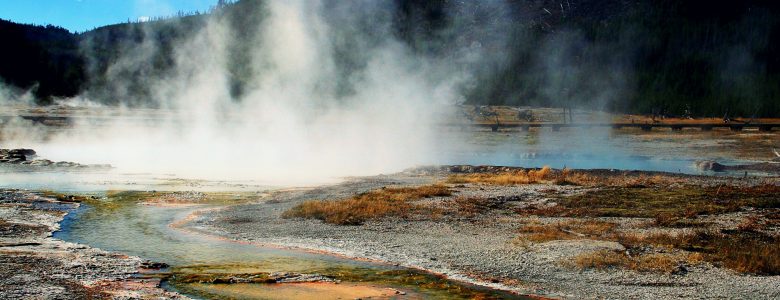March 24, 2019
Thermophiles – Wait, That’s Not a Fetish?

By: burgundy bug
Yellowstone National Park
Source: Boiling Liquid Condensation Geology Geothermal | Pexels
Although the name “thermophile” may throw you for a loop, it is not a reference to those with a burning passion for heat. Rather, it is microscopic bacteria that is able to thrive in boiling water.
Withstanding the Heat
Withstanding the heat is no easy task. Thermophiles must create many additional chemical bonds to stabilize their proteins, according to the textbook Biological Psychology (13th Edition).
Because thermophiles expend a good deal of energy creating these rigid, durable proteins, they are inactive at moderate temperatures.
Some thermophiles require a bit more than just hot water; they need to be in water that is high in sulfuric acid, calcium carbonate, acidic water, or alkaline springs, the Science Education Resource Center of Carleton College reports (SERC CC).
Discovering Thermophiles
Thermophiles were discovered by Thomas Brock in the hot springs of Yellowstone National Park in 1966.
Since then, researchers have found thermophiles in hot springs around the world, including: Iceland, New Zealand, Italy, and Mt. Lassen.
To this day, thermophiles still populate the hot springs of Yellowstone National Park, according to their website.
What Do Thermophiles Do?
Burnin’ Up – Jonas Brothers
Source: Jonas Brothers – Burnin’ Up | Jonas Brothers
There are eight unique species of thermophiles that call the national park their home. While they are microscopic, these bacteria come together to form streamers and mats that we can see without the assistance of a microscope.
In temperatures between 163°F and 198°F, thermophiles form streamers; long, fibrous, flexible bonds in rushing rapids, the Laboratory for Atmospheric and Space Physics at the University of Colorado Boulder reports (LASP CU-Boulder).
On the other hand, thermophiles form mats in water below the temperature of 167°F.
Thermophiles also undergo a process called Oxygenic Photosynthesis, which is the process of creating oxygen by splitting water. This is key to creating an environment in which plants can thrive.
Due to thermophile’s ability to withstand in such extreme conditions, researchers also suspect they may live on other astronomical objects, such as Mars and Jupiter’s moons.
Additionally, the University of Nebraska Lincoln (UN-Lincoln) looked towards thermophiles as a source of renewable energy and environmentally friendly waste water management.
During their study, UN-Lincoln was able to sustain promising energy production over 100-day period at temperatures of 131°F through anaerobic digestion – a process in which microorganisms breakdown biodegradable materials in environments that lack oxygen.
Why Can’t We Survive in Extreme Temperatures?
The average bodily temperature of humans is 98.6°F, give or take a degree here and there. We are endothermic animals, which means our temperature is regulated by internal means. However, we do also rely on external factors to maintain our temperature and actually prefer to do so.
Maintaining a temperature of 98.6°F requires a great deal of energy. In fact, 2/3s of our energy goes towards our basal metabolism, the energy used to maintain bodily temperature at rest.
Our physiological reaction to external temperature is handled by the preoptic area and anterior hypothalamus (POA/AH) in our brains.
The POA/AH receives signals from our skin, internal organs, and hypothalamus to gauge the temperature. In response, it tells us to shiver or sweat depending on the atmospheric conditions.
Humans only have one way to cool themselves in extreme heat: sweating.
In contrast, we have two responses to freezing temperatures: shivering and decreased blood flow to the skin. Decreasing blood flow to the skin diverts heat to our internal organs, but leaves our skin cold to touch.
We also react behaviorally, such as seaking shade in heat, seeking warmth in cold environments, and dressing according to the weather.
Our POA/AH also induces a fever and releases histamines in the event of an infection. Individuals who lack proper receptors in their POA/AH are unable to contract a fever, even in the presence of an infection.
In Conclusion
Burnin’ For You – Blue Oyster Cult
Source: Blue Oyster Cult: Burnin’ For You | BlueOysterWizard
Thermophiles are not a nod towards those who get off to high temperatures. Thermophiles are microscopic bacteria that are able to thrive in extremely hot water, such as the hot springs in Yellowstone National Park.
Through photosynthesis, thermophiles contribute towards sustaining an environment in which plants can survive in.
Additionally, researchers are looking to thermophiles as an environmentally friendly source of energy and wastewater management.
Interested in having content featured in an upcoming blog post or issue of The Burgundy Zine? Head on over to the submissions page!
For all other inquiries, please fulfill a contact form.


